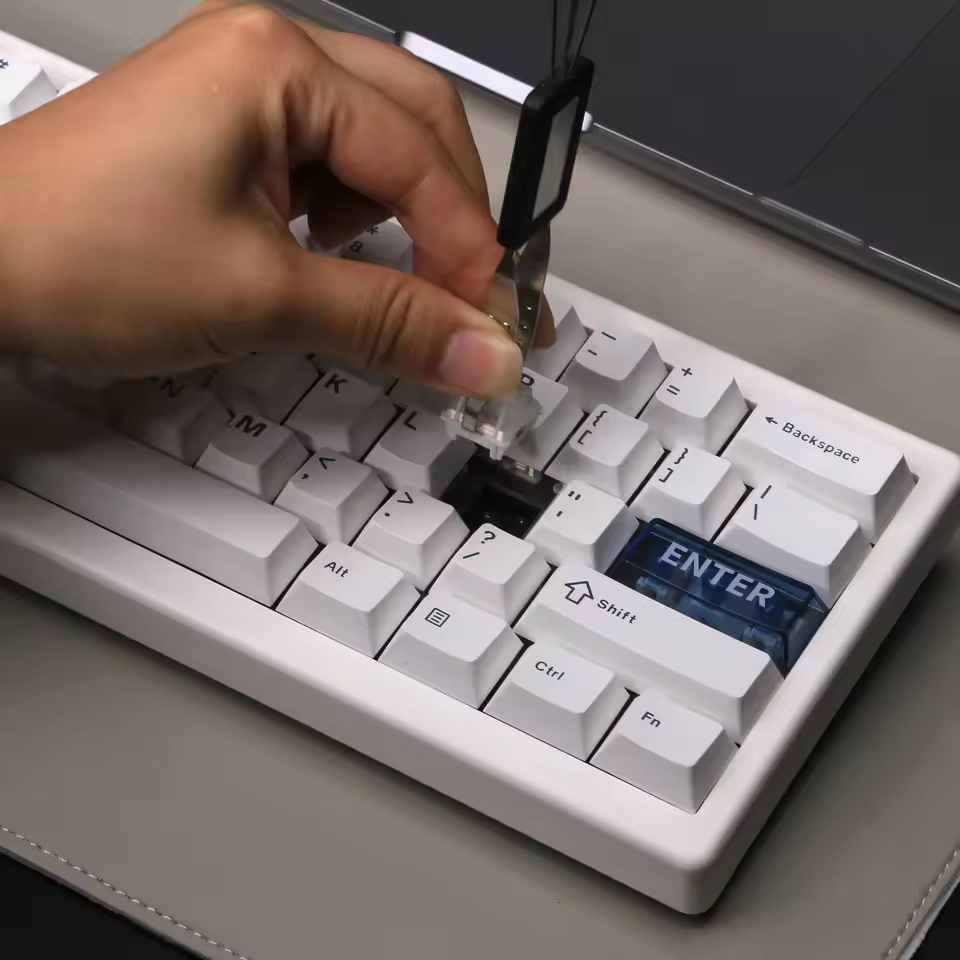Introduction to Bluetooth Keyboards: Why They’re Essential
A bluetooth keyboard has become a staple for modern users who demand flexibility, portability, and seamless connectivity. Whether you’re a student, professional, or casual user, a bluetooth keyboard offers a wireless solution that eliminates clutter and enhances productivity. Unlike traditional wired keyboards, a bluetooth keyboard connects to your devices via Bluetooth technology, allowing you to type from a distance without the hassle of cables. This convenience is particularly valuable for laptops, tablets, and even smartphones, making it a versatile tool for both work and play.
The rise of remote work and mobile computing has further solidified the importance of a bluetooth keyboard. With the ability to pair with multiple devices simultaneously, a bluetooth keyboard ensures you can switch between your laptop, tablet, and smartphone effortlessly. Additionally, advancements in battery life and compact designs have made bluetooth keyboards more practical than ever. From minimalist mechanical models to lightweight foldable options, there’s a bluetooth keyboard to suit every lifestyle. In the following sections, we’ll explore the different types, benefits, and considerations for selecting the perfect bluetooth keyboard for your needs.
Types of Bluetooth Keyboards and Their Features
The market for bluetooth keyboards is diverse, offering a wide range of designs and features to cater to different preferences. Here are the most popular types:
- Mechanical Bluetooth Keyboards: These keyboards use individual mechanical switches under each key, providing a tactile and satisfying typing experience. They’re ideal for users who prioritize durability and sound feedback. However, they tend to be heavier and more expensive than other types.
- Membrane Bluetooth Keyboards: These models feature a single rubber dome under all keys, resulting in a quieter and smoother keystroke. They’re lightweight and affordable, making them a popular choice for casual users.
- Foldable Bluetooth Keyboards: Designed for portability, foldable keyboards are compact and easy to carry. They’re perfect for travelers or students who need a keyboard on the go. However, their keys are often smaller and less responsive compared to full-sized models.
- Compact Bluetooth Keyboards: These keyboards omit the numeric keypad to save space while retaining full functionality. They’re ideal for users who value portability without sacrificing too much typing real estate.
- Ergonomic Bluetooth Keyboards: Built to reduce strain, ergonomic keyboards feature split designs or curved layouts that align with natural hand positions. They’re especially beneficial for individuals who spend long hours typing.
- Backlit Bluetooth Keyboards: Equipped with LED lighting, these keyboards enhance visibility in low-light environments. Some models offer customizable RGB lighting for a personalized aesthetic.
By understanding these categories, you can narrow down your options and select a bluetooth keyboard that aligns with your specific needs and preferences.
How to Choose the Best Bluetooth Keyboard for Your Device
Selecting the right bluetooth keyboard requires careful consideration of several factors. Here’s a step-by-step guide to help you make an informed decision:
Device Compatibility:
- Laptops: Ensure the bluetooth keyboard supports your laptop’s operating system (Windows, macOS, or Chrome OS).
- Tablets: Check if the keyboard is compatible with your tablet’s size and OS (e.g., iPadOS or Android).
- Smartphones: Verify that the keyboard works with your phone’s Bluetooth version and screen size.
Battery Life and Charging:
- Look for a bluetooth keyboard with a battery life of at least 2–3 months on a single charge.
- Consider models with USB-C or wireless charging for convenience.
Key Layout and Design:
- Full-Size vs. Compact: Full-size keyboards include a numeric keypad, while compact models save space.
- Key Travel and Tactile Feedback: Mechanical keyboards offer deeper key travel, while membrane keyboards are lighter but less responsive.
Additional Features:
- Multimedia Controls: Some keyboards include volume, brightness, and shortcut keys for enhanced usability.
- Compatibility with Multiple Devices: Choose a bluetooth keyboard that allows pairing with up to four devices simultaneously.
Portability and Weight:
- Foldable or ultra-thin models are ideal for frequent travelers.
- Ergonomic designs prioritize comfort over portability.
Budget:
- Entry-level bluetooth keyboards start at 50,whilehigh−endmodelswithadvancedfeaturescancost200+.
By prioritizing these criteria, you can find a bluetooth keyboard that balances performance, convenience, and value.
Top Benefits of Using a Bluetooth Keyboard
A bluetooth keyboard offers numerous advantages over traditional wired models. Here are the key benefits:
- Wireless Freedom: Eliminate the need for USB cables, giving you the flexibility to type from across the room.
- Multi-Device Connectivity: Pair your bluetooth keyboard with multiple devices, such as a laptop, tablet, and smartphone, using a single interface.
- Portability: Compact and lightweight designs make bluetooth keyboards easy to carry, whether for commuting or travel.
- Enhanced Productivity: A dedicated keyboard improves typing speed and accuracy, especially for tasks like coding or document editing.
- Compatibility with Tablets and Smartphones: Transform your tablet or phone into a more functional device with a bluetooth keyboard.
- Customization: Many bluetooth keyboards offer programmable keys, RGB lighting, and adjustable settings to suit your preferences.
- Quiet Operation: While not all bluetooth keyboards are silent, some models (e.g., quiet keyboard) are designed to minimize noise for shared spaces.
These benefits make a bluetooth keyboard an essential tool for anyone seeking efficiency and convenience in their digital workflow.
Maintenance and Care Tips for Your Bluetooth Keyboard
To prolong the lifespan of your bluetooth keyboard, follow these maintenance tips:
Cleaning:
- Use a soft microfiber cloth to wipe away dust and debris.
- For deeper cleaning, turn off the keyboard and use compressed air to remove particles from between the keys.
Avoid Spills:
- Keep liquids away from the keyboard to prevent damage. If a spill occurs, immediately power off the device and let it dry completely before use.
Battery Management:
- Charge the keyboard regularly to avoid deep discharge, which can reduce battery longevity.
- Replace the battery (if removable) when its performance declines.
Storage:
- Store the bluetooth keyboard in a cool, dry place to prevent moisture buildup.
- Use a protective case for foldable or portable models.
Software Updates:
- Check for firmware updates from the manufacturer to ensure optimal performance and compatibility.
By adhering to these guidelines, you can maintain your bluetooth keyboard’s functionality and appearance for years to come.
Troubleshooting Common Bluetooth Keyboard Issues
Even the best bluetooth keyboard can encounter occasional problems. Here’s how to resolve common issues:
Connection Problems:
-
- Ensure Bluetooth is enabled on your device and the keyboard is in pairing mode.
- Move closer to the device to improve signal strength.
Low Battery Warnings:
-
- Charge the keyboard immediately to avoid unexpected disconnections.
- Replace the battery if it no longer holds a charge.
Unresponsive Keys:
-
- Clean the keyboard thoroughly to remove dirt or debris.
- Test the keyboard on another device to identify hardware issues.
Interference from Other Devices:
-
- Turn off nearby Bluetooth devices to reduce signal interference.
- Use a keyboard with a dedicated USB dongle for better stability.
Compatibility Issues:
-
- Check the manufacturer’s website for updated drivers or firmware.
- Ensure your device’s operating system is up to date.
By addressing these issues promptly, you can ensure your keyboard remains reliable and functional.
Comparing Keyboards to Wired Keyboards
While keyboards offer unique advantages, they also have limitations compared to wired models. Here’s a detailed comparison:
| Feature | Bluetooth Keyboard | Wired Keyboard |
|---|---|---|
| Connectivity | Wireless (via Bluetooth) | Direct USB connection |
| Portability | Lightweight and cable-free | Heavier due to cables |
| Battery Life | Requires charging or battery replacement | No power source needed |
| Latency | Slight delay possible | Instant response |
| Compatibility | Works with multiple devices | Limited to one device at a time |
| Cost | Generally more expensive | More affordable |
| Durability | Vulnerable to signal interference | More robust and reliable |
For users who prioritize mobility and multi-device support, a keyboard is the clear choice. However, wired keyboards remain superior for tasks requiring zero latency, such as gaming or real-time editing.
Final Thoughts: Is a Bluetooth Keyboard Right for You?
A bluetooth keyboard is an excellent investment for anyone seeking a wireless, versatile, and portable typing solution. Whether you’re a remote worker, student, or creative professional, the benefits of a keyboard—such as multi-device connectivity, reduced clutter, and enhanced productivity—make it a valuable addition to your tech setup. However, it’s essential to weigh the pros and cons based on your specific needs. If you prioritize convenience and portability, a bluetooth keyboard is an ideal choice. But if you require zero latency or a cable-free experience for high-precision tasks like gaming or real-time editing, a wired model might be more suitable.
Consider your usage scenarios, budget, and workspace preferences before making a decision. For most users, the advantages of a keyboard—including its ability to pair with multiple devices, lightweight design, and customizable features—far outweigh its limitations. From eliminating clutter to enabling seamless switching between devices, a keyboard offers unparalleled flexibility. While wired keyboards remain superior for tasks demanding split-second precision, the convenience of Bluetooth technology makes it a top pick for everyday use. Ultimately, choosing the right keyboard depends on balancing performance with personal preferences. A bluetooth keyboard is not just a tool—it’s a gateway to a more efficient and connected digital experience.